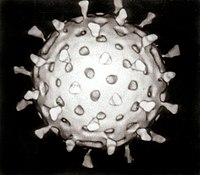
Photo from wikipedia
Diarrhea is the leading cause of childhood morbidity and mortality particularly in developing countries and rotavirus has been identified as the major pathogen associated with diarrheal infections. This study was… Click to show full abstract
Diarrhea is the leading cause of childhood morbidity and mortality particularly in developing countries and rotavirus has been identified as the major pathogen associated with diarrheal infections. This study was conducted to detect genotypic distribution of predominant rotavirus strains circulating in children suffering from acute gastroenteritis in Rawalpindi, Pakistan. Stool specimens were collected from children ≤5 years of age, visiting Military Hospital, Rawalpindi, with signs and symptoms of acute gastroenteritis. Two hundred and eighty‐four specimens were collected during the period from April 2017 to March 2018. Enzyme immunoassay was performed for detection of rotavirus and reverse transcription‐PCR (RT‐PCR) was carried out for amplification of VP7 and VP4 gene segments followed by multiplex PCR using genotype‐specific primers. Out of 284 children, 71 were found rotavirus positive and among them, 54% were females and 46% males. Our findings showed 92% of infection among children ≤2 years of age, while, the peak age of rotavirus incidence was found to be 6–12 months. Although, rotavirus infection was observed throughout the year but frequency increased in winter. Subtype G1P[8] was more prevalent followed by G2P[4], G3P[8], and G4P[6] subtypes. The results of this study provide insight into the disease burden as well as information on rotavirus diversity which will be useful to develop future strategies to control and prevent diarrheal infections among children.
Journal Title: Journal of Medical Virology
Year Published: 2022
Link to full text (if available)
Share on Social Media: Sign Up to like & get
recommendations!